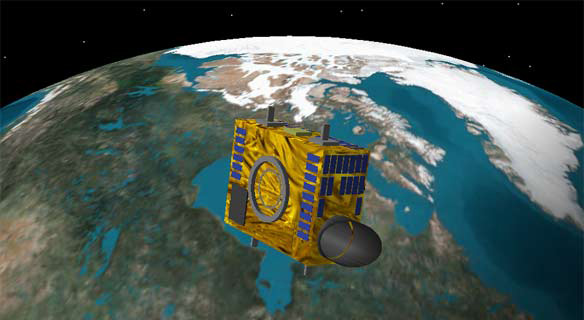Just yesterday (June 30th) was the 100-year anniversary of the Tunguska event, when a small piece of ice or rock exploded in the air near the Podkammenaya Tungus river in Siberia, flattening trees and scaring the heck out of people in the surrounding area. Thankfully, the blast didn’t happen in a populated area and nobody was killed, but there are many more pieces of debris floating around out there in space. If we want to do something about an asteroid headed our way, or keep astronauts safe from space debris, knowing is half the battle. Thanks to a new microsatellite being built by the Canadian Space Agency, we will soon have a better map of the objects surrounding the Earth’s orbit.
The Near Earth Object Surveillance Satellite (NEOSSat) is a small satellite, about the size of a suitcase and weighing 143 pounds (65 kilograms). This puts it in a class of satellites known as “microsatellites”. Canada has already launched a successful microsatellite mission – Microvariability and Oscillation of STars (MOST) – that measured the light oscillation of stars to determine their age.
NEOSSat will monitor asteroids, comets and space junk in near-Earth orbit – within 100 – 1240 miles (160 – 2000 km) – to create a detailed survey of objects close to the Earth. It will also track other satellites, such as geosynchronous satellites, which orbit further out at 22,400 miles (~36,000 km).
NEOSSat wont’ orbit the way many satellites do – around the equator of the Earth – but will rather follow a polar orbit, circling from pole to pole every 50 minutes. This allows it to observe near the Sun where asteroids that orbit uniquely inside the Earth’s orbit are to be found. It will use a sunshade to observe with 45 degrees of the Sun. The polar orbit also gives the spacecraft the ability to use parallax to determine the distance to asteroids, comets and debris
Because of its location outside the Earth’s atmosphere, NEOSSat can also be small – it will use only a 15cm (6 inch) telescope. The small size will make the satellite easy to pack in with another, larger satellite for launch, thus reducing the cost of the mission.
Satellites are much better at making observations because they don’t have to look through the Earth’s thick atmosphere. NEOSSat will provide a huge advantage in surveying the hundreds of thousands of objects surrounding the Earth.
Dr. Alan Hildebrand the Canada Research Chair in Planetary Science in the University of Calgary’s Department of Geoscience said,”NEOSSat being on-orbit will give us terrific skies for observing 24-hours a day, guaranteed. Keeping up with the amount of data streaming back to us will be a challenge, but it will provide us with an unprecedented view of space encompassing Earth’s orbit.”
The mission is funded by as a joint project between the Canadian Space Agency and Defense Research Development Canada.
Source: EurekAlert, NEOSSat


Anent the Tunguska Event of 1908: I got cornered at a party by a fundamentalist who said, “Don’t such things as the way the tunguska body did not hit a heavily populated area prove that God loves us and wants us to prosper?” My answer: “Yes — but it also proves God wants us to survive. Armageddon would total *everything*, and the Rapture would finish it off — nobody surviving on Earth.” For some strange reason he didn’t like that . . . 😉
Very useful
Hmm is it just me or monitoring “asteroids, comets and space junk in near-Earth orbit – within 100 – 1240 miles (160 – 2000 km)” is not going to really help in avoiding any sort of collision with Earth ?
Maybe the launching vehicles can benefit from this but… Asteroids and COMETS within 2000km of Earth ?! I don’t know, it sounds funky…
While this small bird would not save us from an extinction event, learning more about the number and behavior of small objects will add to our knowledge and could led to a meanful defense against these much more numerous and smaller objects. Maybe it could save a city someday.
I have a feeling that cataloging the human artifacts in this area and getting a closer look is a nice side effect that the defense agencies of the Echelon states will all enjoy.
Small nit-pick, but the Tunguska explosion did not create a crater. It was an airburst and it is thought that the blast disintegrated the comet or asteroid entirely.
There are however some who thing that a nearby lake is actually the crater, but it’s just speculation so far.
Good article though, glad to see the the threat of asteroid impacts being taken seriously.
Hmm, I just wonder what NSA and friends think about Candada finding out about the orbit of their top-secret uncatalogued spy-satellites… well I guess most of them are known already through amateur astronomy anyway.
I heard the Canadians if they find a asteroid that will hit earth, they’ll put a big touk on it and throw some back bacon at it, ay?
well, at least, if they help to monito space junk, it’ll be put to good use. If they also use it to study asteriods as well as detecting NEOs, it’d be an effective use of a cut-price launch.
Tyler Durden:
Thanks for the nit-pick, actually. You are totally right that there was no crater created (which is why the event remains so intriguing) and that there is still debate about the nearby lake being created by the blast. I corrected the mistake. Thanks for keeping me honest.
~Nicholos Wethington
Not bad, but written with lotsa stupid obvious explanations, like it was written by and for 10-yr olds, maybe as a mandatory classroom presentation.